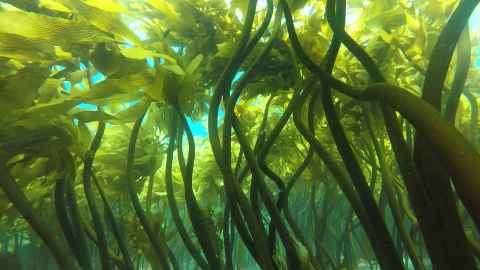A cry for kelp – our kelp forests are in deep trouble
20 October 2024
Opinion: If we don’t address the link between kina predators and the loss of kelp forests, our coasts will remain barren and unproductive says Andrew Jeffs.

As a keen diver for over 50 years on the northeastern coast of New Zealand I’ve witnessed some massive changes in our marine life. The diverse and productive kelp forests that once adorned much of our rocky reefs have been devastated by hordes of kina or sea urchins, leaving a wasteland of bare rock covered in hungry urchins.
It takes large numbers of kina to create a kina barren which can remain that way for decades. In northern New Zealand, large numbers of kina grazing were first seen in the 1960s, a phenomenon that appears to have spread in many areas and is particularly apparent on rocky reefs in the Northland region.
Losing the extensive areas of kelp forest over the past 50 years is destroying the productivity and diversity of our coasts. Kelp forests are crucial in coastal ecosystems – like trees on land, they generate a lot of the food that other creatures rely on, and they provide complex habitats important for fish and other creatures.
We should all be concerned, especially those responsible for managing the situation. Unfortunately, Fisheries New Zealand has claimed there is only equivocal scientific evidence that the disappearance of kelp forests was linked in some way to the overfishing of crayfish – a key kina predator. So when I was approached three years ago by a motivated legal team, Environmental Law Initiative, I was happy to help pull the scientific evidence together to challenge the mistaken view that the link between overfishing and disappearing kelp forests was a fiction.
The evidence, along with evidence from other leading marine scientists and hapū, was presented in the High Court in 2022 to challenge overly generous crayfishing catch allowances set by the Minister of Fisheries for most of Northland, which has been severely affected by loss of kelp forests. The Court agreed with the evidence and directed the minister to take the concerns about the loss of kelp forests into account when setting the crayfishing allowances for Northland.
Unfortunately, the revised decision from the minister in our view still didn’t do enough to effectively deal with the problem, again based on good scientific evidence being overlooked in the decision-making process. So Environmental Law Initiative headed back to the High Court again earlier this year in an effort to get more effective and urgent action from the Minister of Fisheries and his fisheries managers.
Without addressing the link between kina predators and the loss of kelp forests, we will see this ecological issue play out for years to come with our coasts remaining barren and unproductive.
The science overwhelmingly supports closing areas of the ocean to fishing for crayfish; this would allow the crayfish numbers to increase and eat enough kina so that kelp can recover in the barrens, as well as our coastal ecosystems that depends on kelp forest.
Extensive surveys of rocky reef on Northland’s eastern coast in 2017 found 17 percent of the available rocky reef was urchin barren habitat. In contrast, in two marine reserves, where urchin predators like crayfish weren’t fished, the urchin barrens covered only 1 percent of the available rocky reef. There simply is not any good scientific evidence showing that kina barrens can or have developed when the crayfish population is healthy enough to keep the kina population in check.
We’ve seen Fisheries New Zealand attempt to resolve the problem by seeking to increase the recreational limit of kina that can be taken by individuals. Such an approach however does nothing to address the lack of kina predators, like crayfish, that have allowed kina barren to form in the first place.
Without addressing the link between kina predators and the loss of kelp forests, we will see this ecological issue play out for years to come with our coasts remaining barren and unproductive.
Professor Andrew Jeffs is a marine ecologist at the University of Auckland. Besides teaching marine science at the university, he is well known internationally for his research on crayfish.
This article reflects the opinion of the author and not necessarily the views of Waipapa Taumata Rau University of Auckland.
This article was first published on Newsroom, A cry for kelp – our kelp forests are in deep trouble, 20 October, 2024
Media contact
Margo White I Research communications editor
Mob 021 926 408
Email margo.white@auckland.ac.nz